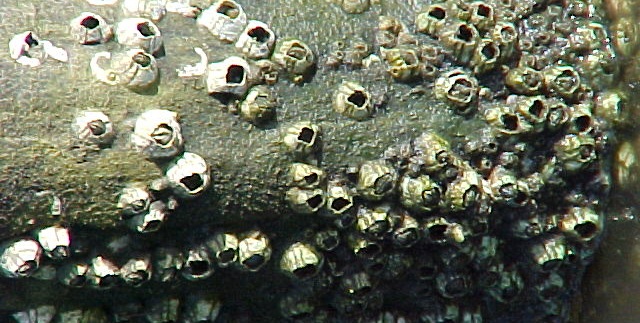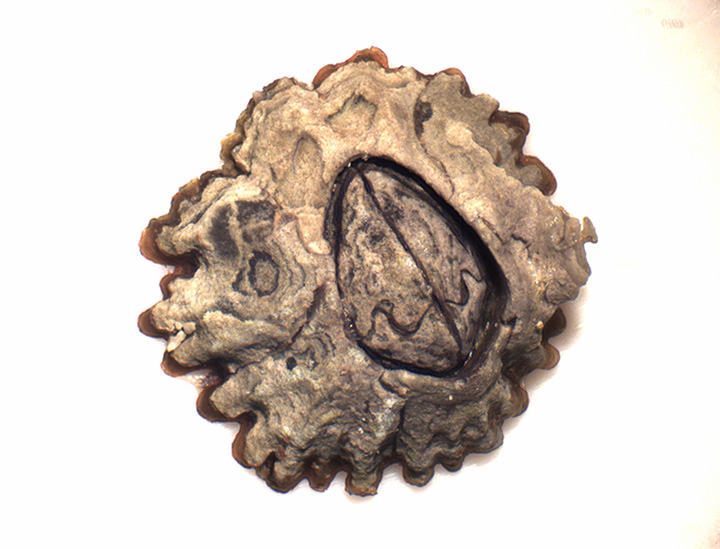Adaptation
Most organisms go through many adaptations in order to survive, however, barnacles are thought to have little adaptations since their discovery. (a-z-animals 2008) Three adaptations of the barnacle Cthamalus fragilis include: their glue-like adhesion, their outer protective shell, and their ability to close their valves in order to avoid drying out.
One feature that many barnacles have that is
unique to them is the glue-like substance that they create that
allows them to attach to hard substrates. Their ability for
underwater adhesion gives them a better opportunity to reach food
and survive, as well as spread all around. The substance formed by
barnacles through cement
polymerization is hypothesized to be relatively comparable to blood
clotting. This cement like fluid contains many proteins and is
produced by special glands. (Multi-Agency Rocky Intertidal Network 20 Oct 2008) This is the fluid
that permanently attaches them to ship hulls, animals, and debris.
Currently, this substance is of particular interest to scientists
and doctors, because there is potential use of this sticky substance
for medical reasons.
Originally testing this glue-like substance proved to be more
difficult than initially expected. Actually obtaining the material
needed to be done carefully. Instead of just cutting dissolving the
glue after cutting off the bottom of the barnacle, researchers
learned how to collect the glue as it was formed and secreted from
the glands. (Bourton
J 2009) Upon deconstruction of the glue, it was found that it works
similar to the clotting of blood.
Another adaptation found in
C. fragilis is their
protective shell. Their hard outer layer often times gives the
misconception that it is a mollusk, however we know that they are
actually under the subphylum crustacea. By combining calcium from
the water, and carbon dioxide, barnacles make calcium carbonate
carina. This is what protects them from predators and their
environment.
Avoiding
desiccation is another feature associated with barnacles.
Desiccation can be problematic for barnacles.
Chthamalus are well
adapted to drying out, giving them an advantage to their
competitors. Because barnacles are incapable of moving freely and
spend most of their life in one location, it is important for them
to be able to adapt to a changing environment, especially in the
intertidal zone where C.
fragilis is found. C.
fragilis is able to adjust to the new environment though a
patterned behavior. Long periods of exposure to high temperature or
air can greatly affect barnacles. Within their respiratory activity,
barnacles use atmospheric oxygen to keep up (Barnes, H and Barnes,
M 1957).
Their ability to close their valves in order to not dry out is an
important process that has been demonstrated.
Overall, barnacles have been around for a
very long time, and their adaptations to their environments as well
as to their predators has given them the ability to stay around and
continue to migrate and evolve.
"Competition and Resource
Scarcity." Global Change. 02 Nov. 2005. University of
Michigan. 20 Oct. 2008
http://www.globalchange.umich.edu/globalchange1/current/lectures/competition/competition.html>.
Knight, K. 2009. Super
sticky barnacle glue cures like blood clots. Journal of Experimental
Biology.
Dougherty, W.J. 1990. Barnacle
adhesion: reattachment of the adult barnacle chthamalus fragilis
Darwin to polystyrene surfaces followed by centrifugational
shearing. Journal of Crustacean Biology 10:469-478.
Oceanic Research Group 2013. <URL:
http://www.oceanicresearch.org/education/wonders/arthropods.htm>.
Accessed 23 March 2014.
A-z-animals 2013. <URL: http://a-z-animals.com/animals/barnacle/>. Accessed 23 March 2014
Bourton, J. 2009. Barnacles’ sticky secret revealed. Earth News
Reporter. BBC Earth News Reporting Life on Earth 2013.
Home | Classification | Habitat | Nutrition | Reproduction | Interactions | Facts | References
| Contact Us |

